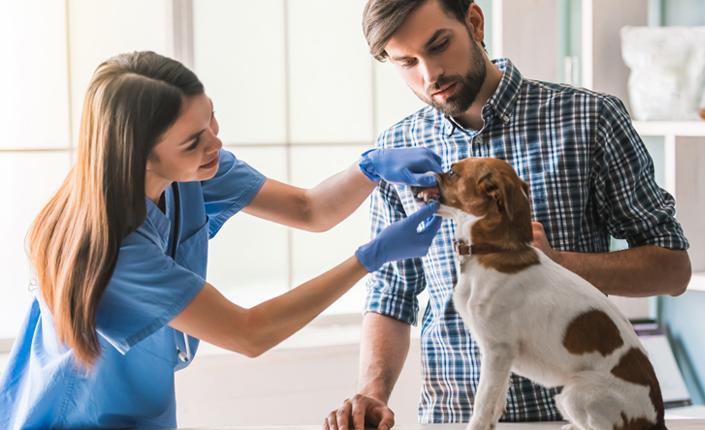
Proper Vet-iquette: 5 Ways To Have Good Manners At The Vet Office
Looking to raise a politer pooch or courteous cat? It all starts with practicing proper etiquette when at the veterinary office.
People bring their pets to the veterinary clinic for a number of reasons; from waiting for a routine check-up to picking up medication. Some pet owners are even facing the difficult decision of saying goodbye to their beloved companions. That’s why it’s important to be respectful of your fellow pet owners, their animals, the veterinarian, and the clinic staff.
Follow our top 5 etiquette tips so your pet’s relationship with the veterinarian can start off on the right paw.
1. Leashes and Carriers
Your pet may be a real social butterfly, but the same can’t always be said for the other animals in the waiting room. Dogs should be kept on a leash and sitting close to you, so you can easily control them. Cats should stay in their carriers until it’s time to see the vet. Finding a counter or chair to place the carrier on or under would be ideal to keep them calm and out of the way of curious pups. It’s all about safety and you don’t want to add to the chaos of the waiting room. Pets that are recovering from surgery or feeling under the weather will also appreciate if you respect their personal space.
2. Don’t Be Tardy
You don’t want your pet to make a bad first impression, do you? Being late can be a real pain when the vet staff is trying to stick to a strict appointment schedule. If it’s your pet’s first visit, you’ll definitely want to arrive early, so you can fill out any necessary paperwork beforehand. So, if you know that Fido has a tendency to take his time when he’s asked to relieve himself outside, make sure you leave ample time for a bathroom break before you hit the road. Then, plug the directions into your phone or GPS so you don’t waste time getting lost.
3. Accidents Will Happen
While it’s best practice to let your dog relieve himself outside of the building before an appointment, sometimes accidents happen (and that’s okay!). An unexpected accident on the waiting room floor may leave you red-faced, but there’s no need to be embarrassed. The staff is used to it and won’t have a problem cleaning up the mess. You don’t want to keep it a secret and let a puddle be a hazard for other pets and their owners.
4. Nervous Pets
The clinic can be a scary place for an anxious pet. The waiting room can be noisy and chaotic, not to mention whatever is waiting behind the examination room door. To lessen your pet’s anxiety, call the main desk from the parking lot and ask if you and your pet can wait in your car until it’s time for your appointment. The familiar surroundings and peaceful atmosphere may help keep your pet calm in a stressful situation. You can also use this strategy when bringing a highly contagious pet for a check-up.
Don’t forget the treats! Some treats, a chew toy or even a favourite blanket can, make your pet feel more at ease in these strange new surroundings.
5. Questions Welcome
When you learn that your pet needs surgery, it’s understandable that you might have what seems like a million questions about what to expect. How long is the procedure? What will recovery look like? Will your pet need medication and if so, what are the side effects? Your veterinarian’s job is to clear up any confusion, so you have complete peace of mind. Be open to listening to the staff’s recommendations and don’t be afraid to ask questions.
A trip to the veterinary clinic can be stressful, but with some cooperation and good manners and positivity, the experience can become a much calmer one for all involved.
